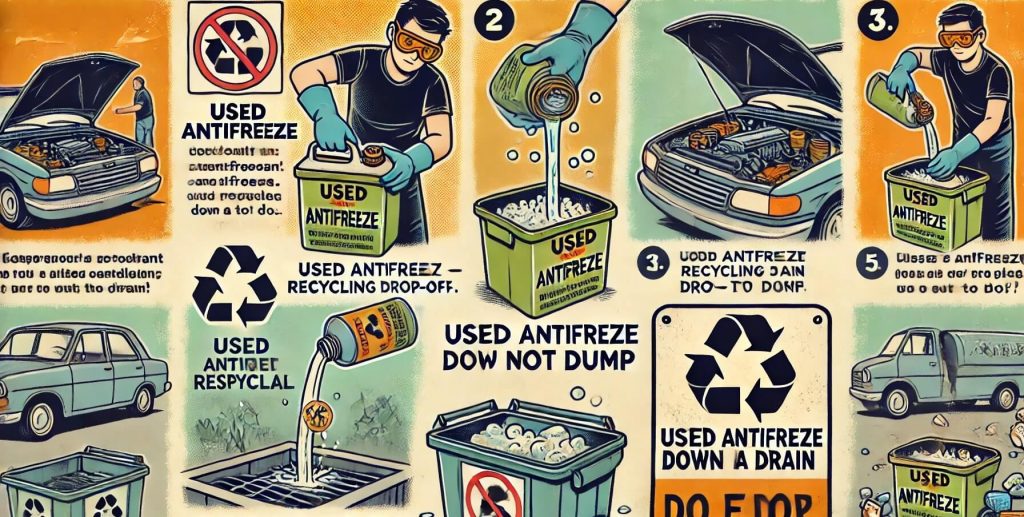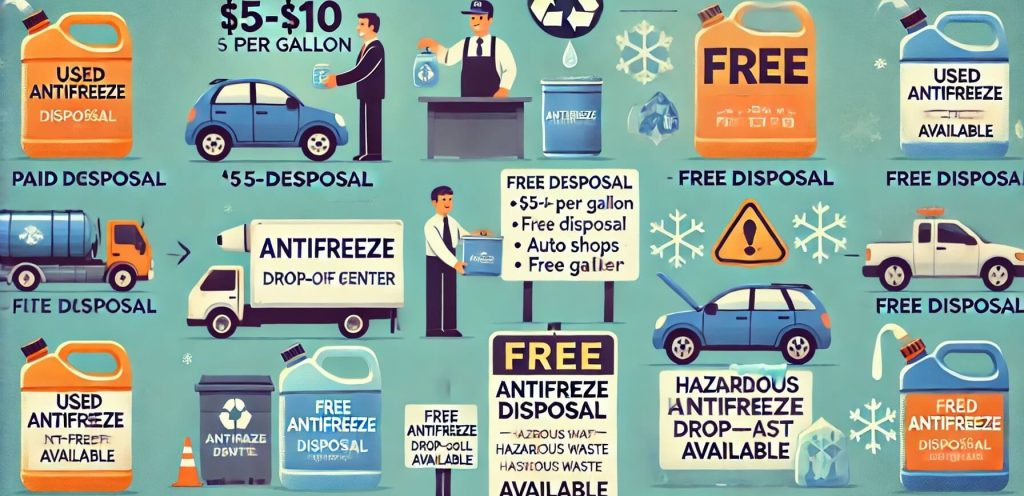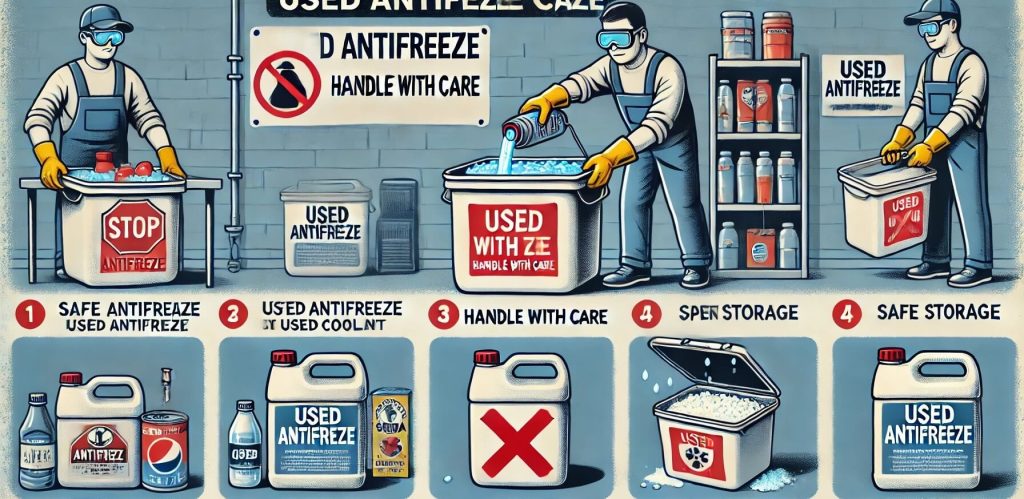Last Updated on February 21, 2025 by Mark S. Taylor
I once found an old jug of radiator fluid in my garage and had no idea what to do with it. I knew I couldn’t just pour it down the drain—coolant disposal is serious business. It’s toxic, bad for the environment, and illegal to dump in many places. After some digging, I learned the right way to dispose of engine coolant safely. If you have old antifreeze sitting around, let’s go over the best ways to get rid of it without harming the planet.

Contents
Why Proper Coolant Disposal Matters
I used to think getting rid of radiator fluid was easy. But then I learned how dangerous it is. Antifreeze is toxic—even a small spill can harm pets, wildlife, and water supplies. It has a sweet smell that attracts animals, but if they drink it, it can be deadly.
So, is dumping antifreeze illegal? In most places, yes. The EPA regulates coolant disposal, and many states have strict rules. Fines can be high if you don’t follow the law. But don’t worry—there are safe and legal ways to get rid of old coolant without harming the planet. Let’s go over your best options.
How to Dispose of Radiator Fluid at Home
I used to think getting rid of old radiator fluid was easy. Just pour it out, right? Wrong. Antifreeze is toxic and can poison pets, harm wildlife, and contaminate water. You can’t flush antifreeze down the toilet or pour it down the drain—it’s dangerous and illegal in most places.
So, what’s the right way? Follow these steps:
- Let your engine cool before draining the radiator. Hot coolant can burn you.
- Use a leak-proof container to store used antifreeze safely.
- Check local disposal sites like auto shops or recycling centers. Many places take it for free.
- Clean up spills fast. Use cat litter or baking soda to absorb the liquid, then sweep it up.
If you ever spill antifreeze, don’t rinse it with water—it can spread the toxins. Instead, neutralize it with an absorbent, then dispose of it properly. Handling coolant the right way keeps your home, pets, and the planet safe.
Where Can I Dispose of Coolant?
The first time I changed my radiator fluid, I had no clue where to take the old stuff. I knew I couldn’t just dump it, but I didn’t know where to go. After some searching, I found out that many auto shops and waste collection sites accept used coolant—some even for free!
So, where can you dispose of coolant? Start by checking your local hazardous waste collection site. Most cities have drop-off locations for antifreeze disposal near me searches. If that’s not an option, auto shops like AutoZone and Walmart may take used coolant. Some locations offer free disposal, while others charge a small fee.
Before you go, call ahead to confirm. Not all stores accept used antifreeze, and some may have limits. Safe disposal protects the environment and keeps harmful chemicals out of our water.
Used Coolant Recycling: An Eco-Friendly Option
I used to think old radiator fluid was just waste. But I found out you can recycle used coolant instead of throwing it away. This helps the environment and keeps harmful chemicals out of water and soil.
So, how do you recycle radiator fluid? Many auto shops and waste centers have coolant recycling programs. They clean the old antifreeze, remove toxins, and restore it for safe use. Some mechanics even use recycled coolant in cars.
Recycling isn’t just good for the planet—it’s simple. Check local antifreeze recycling locations near you. Many places take it for free. It’s an easy way to clean up safely and protect the environment!

Costs and Free Antifreeze Disposal Options
When I first needed to get rid of old radiator fluid, I wasn’t sure if it would cost me anything. Some places charge a small fee, while others offer free antifreeze disposal. Knowing where to go can save you money.
How Much Does It Cost to Dispose of Antifreeze?
Some auto shops charge $5 to $10 per gallon for disposal. Hazardous waste centers may take it for free on certain days. Always call ahead to check the cost before dropping it off.
Finding Free Antifreeze Disposal Near Me
Many cities have hazardous waste programs that collect used coolant for free. Some AutoZone and Walmart locations accept antifreeze, but it depends on the store. Check with local auto shops to see if they offer free disposal.
Auto Shops vs. Hazardous Waste Centers—What’s the Best Option?
Auto shops are convenient, but not all accept coolant. Hazardous waste centers are the best option for free and eco-friendly disposal. Either way, never pour antifreeze down the drain—safe disposal protects the environment!
Storing and Handling Used Coolant Safely
I once left a bottle of used antifreeze in my garage, thinking it was fine. A few days later, I saw a small leak. That’s when I realized coolant needs proper storage to keep it from spilling or becoming a hazard.
Best Way to Store Used Antifreeze Before Disposal
Use a sealed, leak-proof container like an old coolant bottle. Keep it away from kids and pets, as even a small amount can be dangerous. Store it in a cool, dry place until you can take it for disposal.
Signs of Coolant Contamination – When It Needs Special Handling
If coolant looks milky, has oil in it, or smells burnt, it’s likely contaminated. Contaminated antifreeze is hazardous waste and must go to a proper disposal center, not just an auto shop.
Safe Containers and Labeling Tips
Choose a sturdy plastic container with a tight lid—never use food or drink bottles. Label it clearly as “Used Antifreeze” to avoid confusion. Safe storage makes disposal easy and keeps your home and environment protected.

What Happens If You Dump Antifreeze?
A friend once told me about a neighbor who poured old antifreeze into a storm drain. He thought it would just wash away. Instead, he got a huge fine and had to pay for cleanup. Dumping antifreeze is illegal and can harm the environment.
Legal Consequences and Environmental Damage
Antifreeze is toxic and can poison pets, wildlife, and water supplies. Many states have strict laws with fines up to thousands of dollars for improper disposal. Even a small spill can cause big problems.
Stories of Fines and Pollution Risks
Some people have been fined for dumping coolant in driveways, rivers, or drains. If caught, you could face legal trouble and have to pay for cleanup. It’s not worth the risk.
Alternatives to Dumping and Safe Disposal Tips
Instead of dumping, take used coolant to a recycling center, auto shop, or hazardous waste site. Many places offer free antifreeze disposal. It’s easy, legal, and protects the environment.
FAQs: Common Search Queries About How to Dispose of Radiator Fluid
Can I mix old coolant with new coolant?
No, mixing old coolant with new coolant is not safe. Used radiator fluid may be dirty or broken down, which can harm your engine. Always use fresh antifreeze.
Where can I take used coolant near me?
You can drop off used coolant at auto shops, recycling centers, or hazardous waste sites. Search “free antifreeze disposal near me” to find local options.
Is there an expiration date for antifreeze?
Yes, antifreeze lasts 2-5 years depending on the type. Check the label for an expiration date. If it looks cloudy or has debris, it’s time to replace it.
What should I do if I accidentally spill coolant?
Cover the spill with cat litter or baking soda to absorb it. Sweep it up and dispose of it safely. Never rinse antifreeze down a drain—it’s toxic to animals and water.
My Final Thoughts on How to Dispose of Radiator Fluid
If you want to keep your home and the environment safe, knowing how to dispose of radiator fluid is important. Pouring it down the drain is not an option, but safe disposal is easy with the right steps.
Auto shops, recycling centers, and hazardous waste sites can help you get rid of old coolant properly. Next time you change it, take a few extra minutes to dispose of it the right way. Find a local drop-off site today and protect your community!
